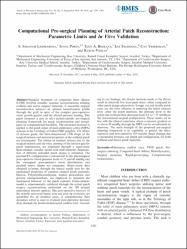| dc.contributor.author | Lashkarinia, S. Samaneh | |
| dc.contributor.author | Pişkin, Şenol | |
| dc.contributor.author | Alkan Bozkaya, Tijen | |
| dc.contributor.author | Salihoğlu, Ece | |
| dc.contributor.author | Yerebakan, Can | |
| dc.contributor.author | Pekkan, Kerem | |
| dc.date.accessioned | 10.07.201910:49:13 | |
| dc.date.accessioned | 2019-07-10T19:50:18Z | |
| dc.date.available | 10.07.201910:49:13 | |
| dc.date.available | 2019-07-10T19:50:18Z | |
| dc.date.issued | 2018 | en_US |
| dc.identifier.citation | Lashkarinia, S. S., Pişkin, Ş., Alkan Bozkaya, T., Salihoğlu, E., Yerebakan, C. ve Pekkan, K. (2018). Computational pre-surgical planning of arterial patch reconstruction: Parametric limits and in vitro validation. Annals of Biomedical Engineering, 46(9), 1292-1308. https://dx.doi.org/10.1007/s10439-018-2043-5 | en_US |
| dc.identifier.issn | 0090-6964 | |
| dc.identifier.issn | 1573-9686 | |
| dc.identifier.uri | https://dx.doi.org/10.1007/s10439-018-2043-5 | |
| dc.identifier.uri | https://hdl.handle.net/20.500.12511/1944 | |
| dc.description | WOS: 000441844800006 | en_US |
| dc.description | PubMed ID: 29761422 | en_US |
| dc.description.abstract | Surgical treatment of congenital heart disease (CHD) involves complex vascular reconstructions utilizing artificial and native surgical materials. A successful surgical reconstruction achieves an optimal hemodynamic profile through the graft in spite of the complex post-operative vessel growth pattern and the altered pressure loading. This paper proposes a new in silico patient-specific pre-surgical planning framework for patch reconstruction and investigates its computational feasibility. The proposed protocol is applied to the patch repair of main pulmonary artery (MPA) stenosis in the Tetralogy of Fallot CHD template. The effects of stenosis grade, the three-dimensional (3D) shape of the surgical incision and material properties of the artificial patch are investigated. The release of residual stresses due to the surgical incision and the extra opening of the incision gap for patch implantation are simulated through a quasi-static finite-element vascular model with shell elements. Implantation of different unloaded patch shapes is simulated. The patched PA configuration is pressurized to the physiological post-operative blood pressure levels of 25 and 45 mmHg and the consequent post-operative stress distributions and patched artery shapes are computed. Stress-strain data obtained in-house, through the biaxial tensile tests for the mechanical properties of common surgical patch materials, Dacron, Polytetrafluoroethylene, human pericardium and porcine xenopericardium, are employed to represent the mechanical behavior of the patch material. Finite-element model is experimentally validated through the actual patch surgery reconstructions performed on the 3D printed anatomical stenosis replicas. The post-operative recovery of the initially narrowed lumen area and post-optortuosity are quantified for all modeled cases. A computational fluid dynamics solver is used to evaluate post-operative pressure drop through the patch-reconstructed outflow tract. According to our findings, the shorter incisions made at the throat result in relatively low local peak stress values compared to other patch design alternatives. Longer cut and double patch cases are the most effective in repairing the initial stenosis level. After the patch insertion, the pressure drop in the artery due to blood flow decreases from 9.8 to 1.35 mm Hg in the conventional surgical configuration. These results are in line with the clinical experience where a pressure gradient at or above 50 mm Hg through the MPA can be an indication to intervene. The main strength of the proposed pre-surgical planning framework is its capability to predict the intraoperative and post-operative 3D vascular shape changes due to intramural pressure, cut length and configuration, for both artificial and native patch materials. | en_US |
| dc.description.sponsorship | European Research Council (ERC); ERC [307460]; TUBITAK 1003 priority-research program [115E690] | en_US |
| dc.description.sponsorship | Funding was provided by Grants from the European Research Council (ERC) Proof of Concept Grant KidsSurgicalPlan, ERC Starting Grant 307460, TUBITAK 1003 priority-research program Grant 115E690. We acknowledge Mohammad Rezaeimoghaddam for his help in CFD simulations. | en_US |
| dc.language.iso | eng | en_US |
| dc.publisher | Springer | en_US |
| dc.rights | info:eu-repo/semantics/openAccess | en_US |
| dc.rights | Attribution 4.0 International | * |
| dc.rights.uri | https://creativecommons.org/licenses/by/4.0/ | * |
| dc.subject | Pulmonary Outflow Tract | en_US |
| dc.subject | PTFE Patch | en_US |
| dc.subject | Presurgical Planning | en_US |
| dc.subject | Congenital Heart Defects | en_US |
| dc.subject | Hemodynamics | en_US |
| dc.subject | Surgical Materials | en_US |
| dc.subject | Rapid-Prototyping | en_US |
| dc.subject | Computational Biomechanics | en_US |
| dc.title | Computational pre-surgical planning of arterial patch reconstruction: Parametric limits and in vitro validation | en_US |
| dc.type | article | en_US |
| dc.relation.ispartof | Annals of Biomedical Engineering | en_US |
| dc.department | İstanbul Medipol Üniversitesi, Tıp Fakültesi, Cerrahi Tıp Bilimleri Bölümü, Kalp ve Damar Cerrahisi Ana Bilim Dalı | en_US |
| dc.identifier.volume | 46 | en_US |
| dc.identifier.issue | 9 | en_US |
| dc.identifier.startpage | 1292 | en_US |
| dc.identifier.endpage | 1308 | en_US |
| dc.relation.ec | info:eu-repo/grantAgreement/TUBITAK/SOBAG/115E690 | en_US |
| dc.relation.publicationcategory | Makale - Uluslararası Hakemli Dergi - Kurum Öğretim Elemanı | en_US |
| dc.identifier.doi | 10.1007/s10439-018-2043-5 | en_US |
| dc.identifier.wosquality | Q2 | en_US |
| dc.identifier.scopusquality | Q1 | en_US |



















